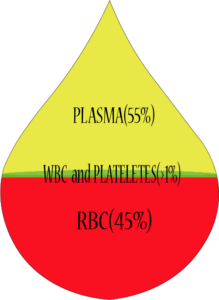What is Blood?
Blood is the life-maintaining fluid that circulates through:
♥ Heart
♥ Arteries
♥ Veins
♥ Capillaries
♥ Brain
♥ Rest of the body
What are the components of Blood?
Blood makes up about 7 percent of your body’s weight.
The components of human blood are:
♥ Plasma. The liquid component of the blood in which the following blood cells are suspended:
♥Red blood cells (erythrocytes). These carry oxygen from the lungs to the rest of the body.
♥White blood cells (leukocytes). These help fight infections and aid in the immune process. Types of white blood cells include: Lymphocytes, Monocytes, Eosinophils, Basophils, Neutrophils
♥ Platelets (thrombocytes). These help in blood clotting.
Why Donate Blood?
♥ Every year our nation requires about 5 Crore units of blood, out of which only a meager 2.5 Crore units of blood are available.
♥ The gift of blood is the gift of life. There is no substitute for human blood.
♥ Every two seconds someone needs blood.
♥ More than 38,000 blood donations are needed every day.
♥ A total of 30 million blood components are transfused each year.
♥ The average red blood cell transfusion is approximately 3 pints.
♥ The blood type most often requested by hospitals is Type O.
♥ Sickle cell patients can require frequent blood transfusions throughout their lives.
♥ More than 1 million new people are diagnosed with cancer each year. Many of them will need blood, sometimes daily, during their chemotherapy treatment.
♥ A single car accident victim can require as many as 100 units of blood.
Advantages:
While donated blood is beneficial for people in need, some medical professionals maintain that donating blood also benefits the donor.
- Reduces Iron Level
- Identifies adverse health effects
- Helps people feel good about themselves
- Burns Calorie
Disadvantages:
When performed in a clean manner, donating blood is safe.
If a blood bank were to reuse needles, this could increase the risk of someone experiencing a blood-borne infection
A person can experience some side effects, as a result of donating blood. These include:
- dizziness
- feeling faint
- Lightheadedness
- nausea
Facts about the Blood supply
♥ Blood cannot be manufactured – it can only come from generous donors.
♥ Type O-negative blood (red cells) can be transfused to patients of all blood types. It is always ingreat demand and often in short supply.
♥ Type AB-positive plasma can be transfused to patients of all other blood types. AB plasma is also usually in short supply.
Blood donation process
Donating blood is a safe process.
♥ A sterile needle is used only once for each donor and then discarded.
♥ Blood donation is a simple four-step process:
REGISTRATION
MINI PHYSICAL CHECK
DONATION
REFRESMENT
♥ Every blood donor is given a mini-physical, checking the donor’s temperature, blood pressure, pulse and hemoglobin to ensure it is safe for the donor to give blood.
♥ The actual blood donation typically takes less than 10-12 minutes. The entire process, from the time you arrive to the time you leave, takes about an hour and 15 min.
♥ The average adult has about 10 units of blood in his body.
♥ Roughly 1 unit is given during a donation.
♥ A healthy donor may donate red blood cells every 56 days, or double red cells every 112 days.
♥ A healthy donor may donate platelets as few as 7 days apart, but a maximum of 24 times a year.
♥ All donated blood is tested for HIV, hepatitis B and C, syphilis and other infectious diseases before it can be transfused to patients.
